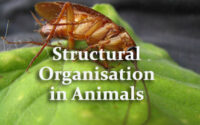Respiration in Plants Questions and Answers
1. Which statement is wrong for Krebs’ cycle?
A. There are three points in the cycle where NAD+ is reduced to NADH + H+
B. There is one point in the cycle where FAD+ is reduced to FADH2
C. During conversion of succinyl CoA to succinic acid, a molecule of GTP is synthesised
D. The cycle starts with condensation of acetyl group (acetyl COA) with pyruvic acid to yield citric acid.
2. Oxidative phosphorylation is-
A. Formation of ATP by energy, released from electrons removed during substrate oxidation.
B. Addition of phosphate group to ATP
C. Oxidation of phosphate group in ATP
D. Formation of ATP by transfer of phosphate group from a substrate to ADP
3. Which of the following biomolecules is common to respiration-mediated breakdown of fats, carbohydrates and proteins?
A. Acetyl CoA
B. Pyruvic acid
C. Fructose 1, 6-bisphosphate
D. Glucose-6-phosphate
4. The chemiosmotic coupling hypothesis of oxidative phosphorylation proposes that adenosine triphosphate (ATP) is formed because——
A. a protons gradient forms across the inner mitochondrial membrane
B. there is a change in the permeability of the inner mitochondrial membrane towards adenosine diphosphate (ADP)
C. high energy bonds are formed in mitochondrial proteins.
D. ADP is pumped out of the matrix into the intermembrane space.
5. The respiratory quotient value of 0.7 is obtained for—
A. Proteins
B. Glucose
C. tripalmitin
D. organic acids
6. In which one of the following steps of citric acid cycle, FAD+ is reduced to FADH2?
A. Pyruvate —> Acetyl coenzyme A
B. Succinic acid —> Malic acid
C. Malic acid -> Oxaloacetic acid
D. α-Ketoglutaric acid —> Succinic acid
7. Which enzyme helps in transfer of phosphate group from ATP to a carbohydrate?
A. ATPase
B. Phosphatase
C. Catalase
D. Phosphorylase
8. TCA cycle enzymes are located in-—
A. Cristae
B. outer membrane
C. mitochondrial matrix
D. mitochondrial intermembrane space
9. FAD is electron acceptor in the citric acid cycle during the oxidation of—
A. malic acid to oxaloacetic acid
B. succinic acid to malic acid
C. citric acid to alpha-ketoglutaric acid
D. alpha-ketoglutaric acid to succinic acid
10. In which one of the following reaction of glycolysis, oxidation takes place?
A. Glucose 6-phosphate to fructose 6-phosphate
B. Fructose 6-phosphate to fructose 1, 6-bisphosphate
C. 1, 3-bisphosphoglycerate to 3-phosphoglyceric acid
D. 3-phosphoglyceraldehyde to 1, 3-bisphosphoglycerate
11. Choose the correct statement.
A. Oxygen is vital in respiration for removal of hydrogen
B. Pyruvate is formed in the mitochondrial matrix
C. There is complete breakdown of glucose in fermentation
D. During the conversion of succinyl CoA to succinic acid a molecule of ATP is synthesised
12. Connecting link between glycolysis and Krebs’ cycle is—
A. PGA
B. Aldehyde
C. ketone acetyl
D. CoA
13. In Krebs’ cycle, the hydrogen of malate is accepted by–
A. FAD
B. NAD
C. FMN
D. CoA
14. Conversion of pyruvic acid into ethyl alcohol is facilitated by the enzymes—
A. Carboxylase
B. Phosphatase
C. Dehydrogenase
D. decarboxylase and dehydrogenase
15. When tripalmitin is used as a respiratory substrate, the value of RQ is—
A. 0.5
B. 1.0
C. 1.7
D. 0.7
16. The key product of glycolysis is—
A. acetyl CoA
B. pyruvic acid
C. citric acid
D. PGA
17. How much of the energy released during aerobic respiration is approximately conserved in the form of ATP—
A. 20%
B. 40%
C. 60%
D. 100%
18. During anaerobic respiration, the conversion of pyruvate into acetaldehyde along with TPP, the cofactor is-—
A. Mg2+
B. Mn2+
C. Fe2+
D. Zn2+
19. What does the following equation representC6H12O6 + 2NAD + 2 ADP + 2Pi -> 2CH3.CO.COOH + 2NADH2 + 2ATP—
A. Complete glycolysis
B. Complete aerobic respiration
C. Complete anaerobic respiration
D. Complete fermentation
20. Which of the two statements together support that respiratory pathway is an ‘amphibolic pathway’—
(i) Fats breakdown to glycerol and fatty acids, subsequently yields acetyl CoA
(ii) In respiration C—C bonds of complex compounds breakdown through oxidation leading to release of energy
(iii) Acetyl CoA from respiratory pathway is withdrawn for synthesis of fatty acids
(iv) Proteins are degraded by protease to amino acids and enter the respiratory pathway
A. (i), (ii)
B. (i), (iv)
C. (ii), (iv)
D. (iii), (ii)
21. Choose the correct sequence of electron pathway in ETS—
A. Cyt oxidase —> Cyt reductase —> Succinate dehydrogenase —> NAD dehydrogenase
B. NADH dehydrogenase —> Succinate dehydrogenase —> Cyt c reductase —> Cyt c oxidase
C. NADH dehydrogenase —> Cyt c reductase —> Cyt c oxidase —> O2
D. Succinic dehydrogenase —> Cyt oxidase —> Cyt. reductase —> O2
22. In which one of the following processes CO2 is not released?
A. Aerobic respiration in plants
B. Aerobic respiration in animals
C. Alcoholic fermentation
D. Lactate fermentation
23. The Respiratory Quotient (RQ) of glucose is—
A. 0.5
B. 0.7
C. 1.0
D. 1.5
24. Out of 38 molecules of ATP produced upon aerobic respiration of glucose, the break up in ATP production in glycolysis (P), pyruvate to acetyl-CoA formation (Q) and Krebs’ cycle (R) is as follows :
A. P=2,Q=6,R=3O
B. P=8,Q=6,R=24
C. P=8,Q=10,R=20
D. P=2, Q = 12, R = 24
25. How many ATPs are produced when one molecule of FADH2 is oxidized to FAD through electron transport system?
A. 2
B. 3
C. 1
D. 4
26. Oxidative decarboxylation of pyruvic acid results in the formation of–
I. Acetyl CoA
II. CO2
III. ATP
IV. NADH + H+
A. I only
B. I and II only
C. I, II and III only
D. I, II and IV only
27. Select the correct order of reactions in glycolysis
A. Conversion of 3-phosphoglyceraldehyde to 1, 3-bisphoswphoglycerate
B. Conversion of 3-phosphoglyceric acid to 2-phospho-glycerate
C. Conversion of BPGA to 3-phosphoglyceric acid
D. Splitting of fructose 1, 6-bisphosphate into dihydroxy acetone phosphate and 3-phosphoglyceraldehyde
A. D C B A
B. B C A B
C. B D A C
D. D A C B
28. In which of the following steps of citric acid cycle, CO2 is evolved?
I. Citric acid —> α-Ketoglutaric acid
II. Succinic acid —> Malic acid
III. Malic acid —> Oxaloacetic acid
IV. α-Ketoglutaric acid —> Succinyl CoA
A. I and II only
B. I and IV only
C. II and III only
D. II and IV only
29. In respiration, more than one R.Q. value results from the use of-
A. Glucose
B. Sucrose
C. fat
D. organic acid
30. During aerobic respiration, acetyl CoA is synthesized in—
A. Cytosol
B. mitochondrial matrix
C. glyoxysomal matrix
D. perichondrial space
31. In lactic acid fermentation, the number of ATP formed by the oxidation of NADH is—
A. Eight
B. Six
C. Three
D. nil
32. A small protein attached to the outer surface of the inner membrane and which acts as a mobile carrier for transfer of electrons between complex III and IV is—
A. cytochrome d
B. cytochrome c
C. cytochrome b
D. cytochrome a
33. During glycolysis, fructose 1, 6-bisphosphate is split into—
A. dihydroxyacetone phosphate and 2-phosphoglyceraldehyde
B. dihydroxyacetone phosphate 1-phosphoglyceraldehyde
C. dihydroxyacetone phosphate 2-phosphoglycerate
D. dihydroxyacetone phosphate and 3-phosphoglyceraldehyde
34. When respiratory quotient is less than 1.0 in a respiratory metabolism, it means that-
A. carbohydrates are used as respiratory substrate
B. volume of carbon dioxide evolved is less than volume of oxygen consumed
C. volume of carbon dioxide evolved is more than volume of oxygen consumed
D. volume of carbon dioxide evolved is equal to volume of oxygen consumed
35. How many NAD molecules get reduced in complete oxidation of one glucose molecule-
A. 2
B. 5
C. 10
D. 12
36. Assertion (A) : RQ value for fats is less than one.
Reason (R) : The amount of CO2 released is less than O2 consumed when fats are used in respiration
A. A is true but R is false
B. A is false but R is true
C. Both A and R are true and R is correct explanation of A
D. Both A and R are true but R is not the correct explanation of A
37. Identify the correct pair of statements-
I. Niacin containing coenzymes facilitates the oxidation of malate in the matrix of mitochondria
II. Heam is the prosthetic group for the enzyme which catalyses the carboxylafion of RuBP in the stroma of chloroplast.
III. The electron carrier between cyt c-oxidase and cyt-c-reductase is attached to inner membrane of mitochondria
IV. Water splitting reaction in the lumen of thylakoid requires chlorine
A. l, II
B. I, IV
C. II, III
D. III, IV
38. In aerobic respiration, total number of ATP molecules formed from 1 glucose molecue is—
A. 28
B. 32
C. 36
D. 30
39. Pyruvic acid, the key product of gIycolysis can have many metabolic fates. Under aerobic condition it forms-
A. lactic acid
B. CO2+ H2O
C. acetyl CoA + CO2
D. ethanol + CO2
40. One molecule of NADH and one molecule of FADH2 yield-
A. 2 and 3 ATP
B. 18 and as ATP
C. 36 and 18 ATP
D. 3 and 2 ATP
41. Which stage of aerobic respiration take place in matrix of mitochondria—
(i) Oxidative decarboxylation of pyruvic acid
(ii) Glycolysis
(iii) Krebs‘ cycle
(iv) Oxidative phosphorylation
A. (i) and (ii) only
B. (ii) and (m) only
C. (iii) and (iv) only
D. (i) and (iii) only
42. Oxidative decarboxylation occurs during the formation of—
A. citric acid and succinic acid
B. citric acid and oxaloacetic acid
C. acetyl CoA and succinyl CoA
D. oxaloacetic acid and oxalosuccinic acid
43. Acetyl coenzyme A can be formed through the process of—
A. Glycolysis
B. β-oxidation of fatty acids
C. deamination of amino acids
D. all of the above
44. Which one is amphibolic—
A. Glycolysis
B. ETC
C. Gluconeogenesis
D. Krebs cycle
45. What is respiratory quotient during germination of fatty seeds—
A. Unity
B. Less than unity
C. More than unity
D. Zero
46. Identify correct pair of statements—
(i) Attraction between two molecules of water present in xylem channel is adhesion
(ii) Number of O2 molecules absorbed is more than number of CO2 molecules released when triolein is respiratory substrate
(iii) Bacillus mycoides is nitrifying bacteria
(iv) Continuous system of cell walls and intercellular space in plant tissues is called apoplast
A. (ii) and (iii)
B. (iii) and (iv)
C. (ii) and (iv)
D. (i) and (iv)
47. How many ATP molecules will be generated in a plant system during complete oxidation of 40 moles of glucose?
A. 190
B. 380
C. 1520
D. 3040
48. Glycolysis term has originated from Greek words-
A. glycose and lysis
B. glycose and lysis
C. glyco and lysis
D. glucose and lysis
49. When fats are respiratory substrate the value of R.Q. would be
A. approx. 0.7
B. approx. 1.0
C. more than 1.0
D. none of these
50. TCA cycle is named after-
A. Embden
B. Hans Krebs
C. Melvin Calvin
D. Robert
51. During movement of electron through ETC—
A. pH of matrix increases
B. electrons are transported by active transport
C. electrons are resonated
D. electrons show fluoroscence
52. In mitochondria, protons accumulate in the-
A. outer membrane
B. inner membrane
C. intermembrane space
D. matrix
53. In the electron transport system present in the inner mitochondrial membrane, complexes l and IV are respectively—
A. NADH dehydrogenase and FADH2
B. FADH2 and NADH dehydrogenase
C. NADH dehydrogenase and cytochrome oxidase complex
D. NADH dehydrogenase and ATP synthase



